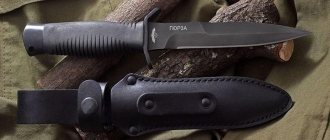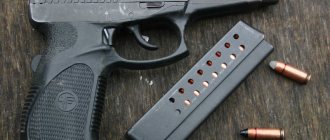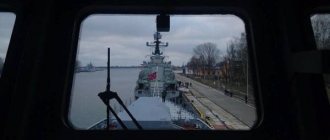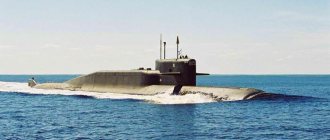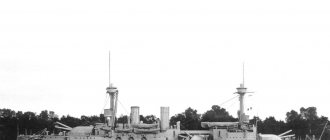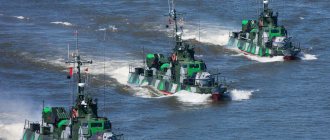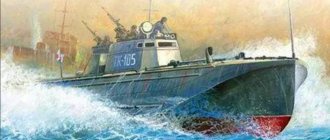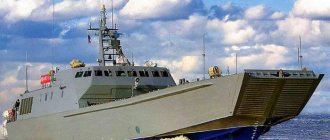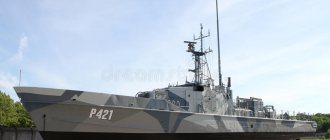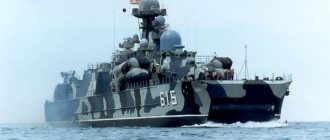Against the background of the next anniversary of Euromaidan, the Ukrainian naval forces fell into nostalgia. On the resources of the Naval Forces of Ukraine, like mushrooms after the rain, texts began to pop up en masse about the countless “victories” of sailors under the yellow-bladed ensign.
For example, about how on November 19, 1992, the control ship “Slavutich”, “seized” from the Black Sea Fleet by the Ukrainian side, famously arrived at the Sevastopol roadstead.
Actually, the “daringness” of that act was that the Ukrainian Ukrainian Armed Forces, in accordance with the decree of the President of Ukraine Leonid Kravchuk , already seemed to exist by November 1992, but this was not yet officially recognized in Moscow. So the Ukrainian “filibusters” on the Slavutich docked in Sevastopol with caution.
Another funny nuance of that story was that the Ukrainian Navy at that time did not yet have its own approved naval flag. Therefore, the Slavutich carried a stern flag and jack, designed and donated to the ship’s crew by the Ukrainian couturier Mikhail Voronin . “Couturier stern flag” - you must agree, it sounds proud!..
On November 21, 1993, the next “victory” happened. The small anti-submarine ship “Lutsk”, built by “young Ukrainian industry ahead of any Soviet schedule,” arrived in Sevastopol. The secret of this trick was simple. The MPK was laid down at the Kiev Shipyard on January 11, 1991, back in the USSR. On December 26, 1992, the new owners of the MPK re-mortgaged the ship for the Ukrainian Navy, after which this date began to appear in the Ukrainian press as the day the construction of the Lutsk began. We forget about the previous two years of construction of the ship - and the record is ready.
The result of all these “overcomes” is known: “Slavutich” and “Lutsk”, like many other ships of the Ukrainian Navy, came under the control of Russia in the spring of 2014. Moreover, the commander of “Lutsk” was even appointed commander of the Russian MPK “Suzdalets” after that.
Where did the “Gyurzas” crawl out from?
The “Crimean Spring” put an end to the history of the Ukrainian Naval Forces as a naval group of any military significance. This was a completely natural result of the existence of the naval forces created by Kiev within the framework of the “Shob Bulo” strategic concept.
In the second half of 2014, a sluggish period of “fleet revival” began in Ukraine. It consisted in the fact that Kiev was begging for warships abroad, over and over again announced the completion of the Vladimir the Great corvette laid down in 2011, and “boosted” the creation of small armored artillery boats (MBAC) of Project 58155 “Gyurza”, which started back in 2012 -M."
At the moment, only the latter have managed to actually replenish the composition of the Ukrainian Naval Forces. But how much this has strengthened Ukraine’s combat potential at sea is a controversial question. If only for the reason that the “Gyurzas” were at sea, according to the original idea, they should have acted last.
The history of these armored boats began... with the terrorist attacks in the United States on September 11, 2001. After airliners hijacked by Al-Qaeda1 terrorists (a terrorist organization banned in the Russian Federation) crashed into the World Trade Center towers and the Pentagon building, the Americans initiated Operation Enduring Freedom in Afghanistan. At the same time, they received temporary use of the Khanabad airfield on the territory of Uzbekistan. One of the conditions for this was that Tashkent received financial assistance from Washington in the amount of $5.6 million to modernize the equipment of the Termez river flotilla of the border troops of Uzbekistan.
Press service of the Naval Forces of Ukraine /
The main task of this flotilla was to control the 156-kilometer border with Afghanistan along the Amu Darya River. That is, first of all, it was about combating drug trafficking, smuggling and illegal migration.
By the early 2000s, the river armored boats that Uzbekistan inherited from the USSR had exhausted their service life and required replacement. So the American monetary “adjustment” turned out to be very useful for the Uzbeks.
Since Uzbekistan had money, they quickly found those who were ready to build new armored boats for the Termez flotilla. The Nikolaev state enterprise “Research and Design Center for Shipbuilding” was going through hard times due to a lack of orders, so for the Ukrainians the Uzbek order for the design of river armored boats turned out to be manna from heaven.
The terms of reference were simple. The Uzbeks needed a small, shallow-draft, flat-bottomed boat with bulletproof armor and unified armament with infantry fighting vehicles and armored personnel carriers, capable of fitting into the An-124 Ruslan. This is exactly the type of boat of project 58150 code “Gyurza” that was designed in Nikolaev.
Equipped with water cannons, the MBAK “held” 7.62 mm bullets, weighed 30 tons, was armed with turrets from the BMP-2 and BTR-70, and also, with the wheelhouse removed, fit into the Ruslan. A “bonus” to these tactical and technical characteristics was the newfangled “stealth” nature of the MBAK declared by the designers. In cross section, the boat's hull had the shape of a flat hexagon. Theoretically, this should have provided the Gyurze with a significant increase in the area of radar reflectivity.
The customer did not quite understand why he needed stealth boats on the Amu Darya. But he immediately expressed doubts about the advisability of having on a river armored boat a large and visible from afar conning tower, easily pierced through with a heavy machine gun.
However, the Ukrainians managed to convince the Uzbeks that everything was in order with the superstructure. After all, they won’t be hitting “Gyurza” with a “machine gun” every day! And without such a cabin, there is no “steelness” at all, and there is nowhere else to stick a microwave with a refrigerator on the boat. As a result, the lightly armored large wheelhouse was left on the MBAK...
Notes
- [bastion-opk.ru/58150-gurza Project 58150 river armored boat “Gyurza” (Ukraine)]
- [www.chezara.com/cont/prod/special_prod/btr/triada.php Product “TRIADA”]
- [flot2017.com/posts/new/gjurza_dlja_ukrainskih_vms “Gyurza” for the Ukrainian Navy]
- [warspot.ru/2243-gyurza-na-sluzhbe-vms-ukrainy “Gyurza” in the service of the Ukrainian Navy]
- [www.youtube.com/watch?v=Xt2co2maYnw&feature=plcp Video with presentation and interview]
- [www.rnbo.gov.ua/gallery/158.html 11 leaf fall with the participation of the Secretary of the RNBO Oleksandr Turchynov witnessed the launch of a new armored artillery boat of the “Gyurza-M” class]
- Olga Filatova.
[uinp.info/important_news/zavod_poroshenko_delaet_brakovannye_bronekatera_dlya_vms_ukrainy Poroshenko’s plant makes defective armored boats for the Ukrainian Navy] (Russian). Ukrainian independent news portal (July 3, 2016). Retrieved October 5, 2016. - [nr2.com.ua/News/Ukraine_and_Europe/VSU-poluchat-20-bronekaterov-Gyurza-99458.html The Ukrainian Armed Forces will receive 20 Gyurza armored boats]
- [www.lk.com.ua/news/?lang=ru&p=34 Public Joint Stock Company]
- ↑ 12
[svpressa.ru/war21/article/121794/?rpop=1 “Gyurza-M” will crawl towards Mariupol] - ↑ 12
[www.ukrinform.ua/rubric-society/1996384-na-leninskij-kuzni-pocali-budivnictvo-cotiroh-bronovanih-kateriv.html# Four booked boats have started operating at the Leninsky Forge] - [files.balancer.ru/forums/attaches/2015/03/01-3761280-zakladnaya-doska.jpg Mortgage plate of the armored boat “BK-02”]
- ↑ 1234
[www.ukrinform.ua/rubric-society/1996384-na-leninskij-kuzni-pocali-budivnictvo-cotiroh-bronovanih-kateriv.html# Four booked boats have started operating at the Lenin Forge - News Ukrinform]. www.ukrinform.ua. Retrieved April 7, 2016.
And here is our super-duper stealth!
During February-December 2004, two Gyurzas, Jayhun and Saihun, were built by PrJSC, tested, transported by Ruslans to Uzbekistan and delivered to the customer. After this, the Gyurzas were forgotten for six years, until an SOS came from the Izmail detachment of the Ukrainian maritime guard.
In 2010, Izmail border guards found themselves in approximately the same situation as Uzbek river border guards in the early 2000s. The Ukrainians' Soviet boats had completely exhausted their service life, and they no longer had spare parts for them. At the same time, the Romanian neighbors on the Danube had not only artillery boats, but even monitors with 100-mm guns.
True, the Ukrainians, unlike the Uzbeks, did not have American money. Therefore, Ukraine was engaged in resuscitation of the Gyurza project for itself, its beloved, much more slowly than in the construction of MBAKs for Uzbekistan.
Various approvals took a lot of time. During the latter, it was decided that the Ukrainian “Gyurza” should, firstly, be larger than the Uzbek “Gyurza”, and secondly, better armed.
The version of the MBAK modernized by Ukraine for Ukraine became known as project 58155 “Gyurza-M”. The total displacement of the old-new MBAK reached 50.7 tons, which no longer allowed the Gyurza-M to be carried by plane, but still left the opportunity to roll the boat overland on a highway. But be careful. But it did.
facebook.com / Ukrainian Navy
Yes, the displacement of the boat had to be increased - otherwise it was simply not possible to provide the Gyurze-M with the ability required by the border guards to operate near the sea coast. However, Project 58155 still did not shine with seaworthiness. Yes, no one demanded this from him. The “prikordonniks” only wanted the Gyurzy-M from the Danube to be able to travel by water to Odessa under their own power.
The increase in the dimensions of the MBAK made it possible to visually detect the Gyurza-M from a greater distance than the Gyurza. But the increase in the size of the boat gave the Ukrainians the opportunity to strengthen the armament of the MBAK. The weapon system itself was selected on the basis that the Gyurza-M would operate on border rivers and lakes, that is, with minimal disturbance. In such conditions, the MBAK should have been able to fight enemy manpower and light armored vehicles at direct range. At the same time, the developers of the Gyurza-M, with an eye to the experience of the Gyurza, also decided to unify the armament of the armored boat with the armament of ground armored vehicles.
This is how it turned out that two combat modules developed for the BTR-3E armored personnel carrier were registered on the Gyurza-M. The standard equipment of one such module included a 30-mm ZTM1 automatic cannon, a 30-mm automatic grenade launcher, a 7.62-mm PKT machine gun and a Barrier ATGM, which has a target range of 5 km.
The Ukrainians gave the module installed on the MBAK a new name - BM-5M.01 “Katran-M”, which, in fact, ended the “destruction” of the Gyurza-M weapons complex.
And then it was fun.
After reviewing the performance characteristics of project 58155, the Ukrainian Navy announced that they also want such boats for themselves! A departmental squabble arose between Ukrainian sailors and border guards, from which the Ukrainian Ukrainian Armed Forces emerged victorious.
It was difficult to understand why the naval forces needed boats armed with armored personnel carriers and their seaworthiness. Apparently, that same irresistible argument was put into action again - “It’s a shame!”
One way or another, it worked. On October 25, 2012, the first pair of Gyurza-M MBAKs was laid down at the same private joint-stock company. It was laid down and... stuck on the stocks due to a chronic lack of finances. Two unfinished boats rusted on the stocks until the “Crimean Spring”, when it suddenly became clear that only the name remained of the Navy.
The Navy had to be revived, but at what cost?
facebook.com / Ukrainian Navy
“We have two super-duper newest stealth boats! We urgently need government money to complete their construction!” — the owner of the private joint stock company and, concurrently, the slightly new President of Ukraine, Petro Poroshenko, .
It is clear that in such a situation the President of Ukraine could not refuse the owner of “Kuznitsa”. And he didn’t refuse. Finances were immediately allocated and work began to boil. On November 11, 2015, the first two Gyurza-Ms were launched and began testing them. In the sea.
After which it became even more fun.
The gun doesn't fire, the ATGM doesn't fly
The seaworthiness of MBAKs in “non-target” conditions of use turned out to be predictably disgusting. But at least this was expected. What everyone somehow forgot about in the post-Maidan frenzy was that the MBAK weapons complex was not entirely naval. More precisely, not sea at all. Which, in conditions of sea motion and splashing with salt water, immediately had an effect.
The Triad universal fire control complex stubbornly refused to work correctly. Something was constantly short-circuiting and failing. The aiming drives of the combat modules worked with such jerks that the weapon was able to be aimed not where it was needed, but simply “somewhere.”
By the time MBAKs were put into operation, these problems had only been partially overcome. Moreover, the Ukrainians have not yet been able to achieve reliable functioning of the MBAK weapons complex. At the same time, the most problems arose with the “shuttleing” of the Barrier ATGM, which in the boat version was called Barrier-VK.
Salt and constant moisture quickly rendered the missile in the ATGM launch container inoperable. Therefore, the Barriers had to be stored inside the boat - where, according to the project, the reconnaissance and landing group was supposed to sit. But that’s half the trouble!
The main problem was the semi-automatic laser beam guidance system used in the Barrier. To hit the target, the Barrier operator must continuously keep the laser beam on the target after launching the missile. On land, when firing from an armored personnel carrier standing still, such a system worked quite well. But when firing from an actively maneuvering boat burrowing into the sea waves, and even constantly surrounded by a curtain of spray, this system did not work at all.
By August 2022, the Ukrainian Ukrainian Armed Forces already had six small armored artillery boats of Project 58155, but this did not bring the Ukrainians any closer to solving the problem of how to get the Barrier to get where it needed to be. Therefore, while Kyiv propagandists were vividly discussing how a “wolf pack” of MBAKs would instantly tear to pieces the flagship of the Black Sea Fleet, the missile cruiser “Moskva,” the “Gyurza-M” themselves were patrolling at sea with “empty holsters.” The Barrier-VK ATGMs were not in their regular places. The combat modules were decorated only with empty casings for ATGMs.
Tests of ATGMs continuously “finished” by Ukrainians have consistently proven the same thing. In good weather, from a large ship, which is subject to pitching and splashing much less than a boat, hitting a target with a Barrier is possible. Moreover, it is a stationary target. With the MBAK, hitting the same target with the Barrier is only possible if the sea is completely calm and the boat itself is unable to move. That is, it is an excellent target.
This is how it happened that Ukrainian MBAKs, nominally armed with missiles since 2015, were officially fired for the first time only on November 19, 2022. More precisely, one BK-04 “Kremenchug” boat was shot in the testing conditions of the Azov Sea. Being on the “stop”, in the calm, at stationary targets.
From the outside, it must be assumed that the Russian PSKR watched this comedy not without interest.
“In the area of the shooting, a border ship of the FSB of the Russian Federation was noticed, which was constantly located near the area of the shooting,” this is how this moment looked as presented by the Ukrainians. “There were no provocations from the Russian border guards.”
“Growing up” from Uzbek “drug-trafficking hunters,” the Ukrainian “Gyurza-M” were, in fact, armored personnel carriers forcibly driven into the sea, and they remained so - with all the ensuing consequences.
By the way, you shouldn’t overestimate the “lethality” of ATGMs against relatively large naval targets (and it’s not easy to hit small ones with ATGMs). For example, on November 21, MPAC Mk 3 boats of the Philippine Navy fired Spike-ER ATGMs at a surface target for the first time. The target was the decommissioned missile boat BRP Dionisio Ojeda (PG-117), quite comparable in size and tonnage to the Russian PSKR.
What do we see in the video posted online? That the Filipinos shoot from anti-tank systems in the same way as the Ukrainians. From a stop, in calm weather, at a stationary target. Moreover, even after a direct hit by a missile on a target, to put it mildly, it is in no hurry to sink to the bottom...
We will not analyze the real “stealth” nature of Ukrainian MBAKs - FAN has already done this before. Let us only note that it is greatly exaggerated in the Ukrainian media.
Links
- [odnarodyna.com.ua/node/10723 Laying down the Gyurza-M armored boats for the Ukrainian Navy]
- [www.lk.com.ua/specials/military/project58150.php?lang=ru PROJECT 58150 RIVER ARMORED ARTILLERY BOAT “GYURZA”]
- [korabley.net/news/rechnye_bronirovannye_artillerijskie_katera_tipa_gjurza_proekta_58150/2010-02-13-481 River armored artillery boats of the “Gyurza” type, project 58150]
- [sd.net.ua/2013/01/03/ukraina-zavershaet-sozdanie-rechnogo-voennogo.html Ukraine is completing the creation of a river navy]
- [maxpark.com/community/547/content/1792506 “Gyurza” for the Ukrainian Navy]
- [topwar.ru/5409-proekt-bronekatera-gyurza.html Project of the armored boat "Gyurza"]
- [warspot.ru/2243-gyurza-na-sluzhbe-vms-ukrainy “Gyurza” in the service of the Ukrainian Navy]
